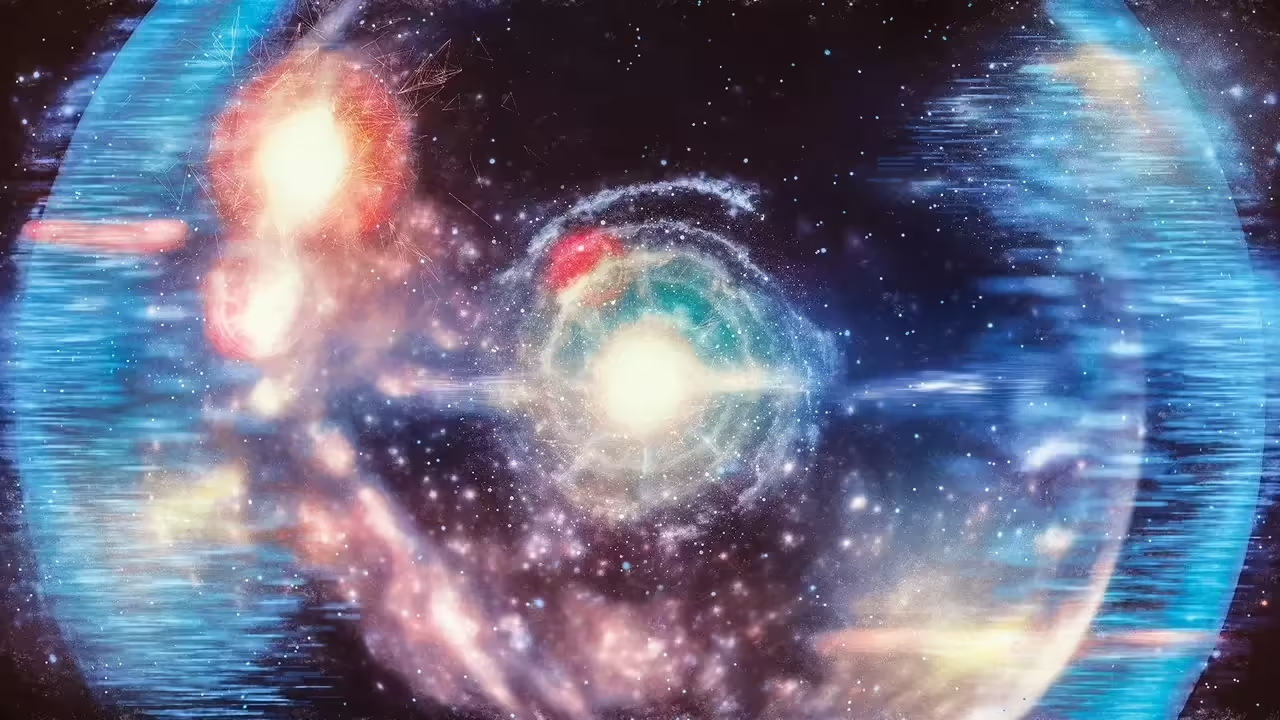
What will happen when the universe comes to its end? Is there a way to avoid it or escape from it? These are some of the questions posed by scientists studying the ultimate fate of the cosmos. In this article, we will explore different theories attempting to explain how and when the universe will end and what consequences it will have for life and matter.
One of the most accepted theories is the Big Rip, which predicts that the universe will expand faster and faster due to dark energy, a mysterious force acting against gravity. According to this theory, at a certain point, the expansion will be so violent that it will tear apart all existing structures, from galaxies to atoms, leaving only an infinite void.
Another theory is the Big Crunch, proposing that the universe will contract instead of expanding because gravity will overcome dark energy. In this scenario, the universe will return to its original state of singularity, a point of infinite density and temperature where the laws of physics do not apply.
There is also the theory of the Big Freeze, suggesting that the universe will continue expanding indefinitely but at an increasingly slower pace until reaching a state of thermal equilibrium. This means that the temperature of the universe will approach absolute zero, and all energy and information will be lost. In this case, the universe will become a dark, cold, and inert place.
Finally, there is a more optimistic theory, the Big Bounce, asserting that the universe has neither a beginning nor an end but is cyclic. According to this idea, the universe goes through alternating phases of expansion and contraction, and each time it reaches an extreme, it bounces back and starts anew. Thus, the universe would be eternal and immortal.
These are just some of the possible ways the universe could end, but there are many more. The truth is that no one knows for certain what will happen in the distant future of the cosmos, not even if we can observe or influence it. All we can do is continue researching and marveling at the mysteries of the universe.
The Accelerated Expansion of the Universe: The Rapid Pace of the Cosmos
The cosmos, our vast expanse of space and time, is in a state of constant motion. One of the most intriguing phenomena challenging our understanding is the accelerated expansion of the universe. This cosmic acceleration, initially a controversial concept, has become a focal point in the realms of astrophysics and cosmology.
Understanding Cosmic Expansion: A Brief Overview
The idea that the universe is expanding dates back to the early 20th century, thanks to the groundbreaking work of astronomers like Edwin Hubble. However, it was the late 20th century that brought a startling revelation – not only is the universe expanding, but its expansion is accelerating. This revelation defied conventional expectations and set the stage for an era of profound cosmological inquiry.
The Quest for Answers: Dark Energy Unveiled
At the heart of the accelerated expansion lies a mysterious force known as dark energy. This enigmatic entity, comprising about 68% of the universe, exerts a repulsive influence, driving galaxies apart at an ever-increasing rate. The true nature of dark energy remains one of the most pressing questions in modern astrophysics. Is it a constant, or does its influence evolve with time? Scientists grapple with these questions, seeking to unlock the secrets hidden within the fabric of space.
Cosmic Tug-of-War: Balancing Forces in the Universe
To comprehend the accelerated expansion, scientists explore the delicate interplay between dark energy and the attractive force of gravity. While gravity acts as a cosmic glue, pulling matter together into galaxies and clusters, dark energy acts in opposition, pushing celestial bodies away from each other. The balance between these forces determines the fate of the universe and shapes the cosmic landscape on the grandest scales.
Observational Evidence: Probing the Mysteries of Dark Energy
Various observational methods, from studying distant supernovae to analyzing the cosmic microwave background radiation, contribute to our understanding of dark energy. These observations have led to the formulation of intriguing cosmological models, such as the Lambda-CDM model, which incorporates dark energy as a cosmological constant.
Theoretical Frontiers: Exploring New Paradigms
As scientists strive to unravel the mysteries of dark energy, alternative theories and models emerge. Some propose modifications to Einstein’s theory of general relativity, while others explore the possibility of a dynamic dark energy component. These theoretical frontiers aim to refine our understanding of the forces shaping the cosmos and to reconcile observational data with the fundamental laws of physics.
Theories on the Cosmic Future: Exploring Possible Scenarios for the End of the Universe
As we gaze into the vastness of the cosmos, the question of the universe’s ultimate fate looms large. Theories on the future of the cosmos offer glimpses into possible scenarios that stretch the boundaries of our understanding.
The Big Freeze: Entropy’s Relentless March
One prominent theory suggests a cosmic fate known as the “Big Freeze.” As the universe continues its accelerated expansion, galaxies drift farther apart, and stars exhaust their fuel. Ultimately, the cosmos becomes a cold, desolate expanse, with temperatures approaching absolute zero. The relentless march of entropy leaves a legacy of darkness and stillness, marking the end of the cosmic dance.
The Big Crunch: A Cosmic Reversal
Contrary to the Big Freeze, the Big Crunch proposes a scenario where the universe’s expansion halts and reverses. Gravity, the cosmic architect, pulls everything back toward a central point, leading to a dramatic collapse. This theory envisions a fiery and cataclysmic end, with matter compressed to extreme densities. While once a leading hypothesis, current observational data suggests that the universe’s expansion may be accelerating, dampening the prospects of a cosmic crunch.
The Big Rip: Tearing the Cosmic Fabric
A more speculative theory, the Big Rip, foresees a dramatic conclusion to the universe’s story. In this scenario, dark energy’s influence intensifies over time, overcoming gravity and tearing apart galaxies, stars, and even subatomic particles. The cosmic fabric unravels in an explosive fashion, resulting in the ultimate disintegration of all structures, from the largest galaxies to the smallest building blocks of matter.
Heat Death and Quantum Possibilities: Into the Quantum Realm
The concept of heat death suggests a gradual decline into a state of maximum entropy, where all energy gradients are exhausted. However, quantum mechanics introduces intriguing possibilities that challenge this narrative. Quantum fluctuations may give rise to new universes, birthing a cosmic cycle that extends beyond the apparent boundaries of our observable universe.
Multiverse Theories: A Tapestry of Universes
Some theories propose the existence of a multiverse, where our universe is just one thread in a vast tapestry of interconnected universes. In this intricate cosmic dance, each universe follows its own destiny, with varied laws of physics and potential fates. The multiverse concept expands our contemplation of the cosmic future beyond the confines of a single universe.
Invisible Player in the Cosmic Finale
In the grand cosmic theater, an invisible actor takes center stage, exerting a profound influence on the fate of the universe. This unseen force is none other than dark matter, a mysterious entity that permeates the cosmos, leaving its mark on the celestial ballet.
Dark Matter Unveiled: A Cosmic Detective Story
The saga of dark matter begins with its elusive nature. Unlike ordinary matter, dark matter does not emit, absorb, or reflect light, rendering it invisible to conventional telescopes. Its presence is detected indirectly, through its gravitational effects on visible matter. This cosmic detective story has captivated scientists, compelling them to unravel the mysteries hidden within the cosmic shadows.
Galactic Architects: Dark Matter’s Gravitational Embrace
Dark matter’s gravitational influence extends across cosmic scales, sculpting the large-scale structure of the universe. From the cosmic web that connects galaxies to the vast voids that separate them, dark matter serves as an unseen architect, shaping the cosmic landscape. Understanding its role in galactic formation provides crucial insights into the intricate dance of matter on the celestial stage.
The Cosmic Glue: Dark Matter’s Role in Galaxy Formation
As galaxies evolve, dark matter plays a pivotal role in their dynamics. Its gravitational pull provides the necessary scaffolding for the formation and stability of galaxies. While visible matter, such as stars and gas, occupies the spotlight, dark matter silently orchestrates the cosmic choreography, ensuring the cohesion and structure of galactic communities.
Dark Matter and the Accelerated Expansion: A Balancing Act
In the cosmic ballet, dark matter’s influence extends beyond galaxies and intertwines with the broader narrative of the universe’s fate. As the cosmos experiences accelerated expansion, dark matter’s gravitational pull attempts to counterbalance the repulsive force of dark energy. This delicate interplay between cosmic forces shapes the ultimate destiny of the universe.
Searching for Dark Matter: Cosmic Explorer’s Quest
Despite its pervasive influence, the nature of dark matter remains a tantalizing mystery. Scientific endeavors, from deep-space observations to high-energy particle experiments, seek to unmask this elusive actor. The quest for dark matter extends beyond theoretical speculation, inviting us to explore the frontiers of our understanding and redefine the cosmic narrative.
The Philosophy Behind the End: Cosmic Reflections
The scientific lens provides us with a methodical and empirical approach to understanding the universe’s fate. Observations, experiments, and mathematical models offer insights into the mechanisms driving cosmic evolution. From the acceleration of the universe to the mysterious forces shaping its destiny, science provides a language to decipher the cosmic narrative, allowing us to unravel the mysteries hidden within the fabric of space and time.
Philosophical Contemplation: Beyond the Observable
Yet, beyond the empirical confines of scientific inquiry lies the realm of philosophy, where questions of meaning, purpose, and existence come to the fore. The finitude of the cosmos prompts philosophical contemplation on the nature of time, the meaning of our cosmic existence, and the implications of an eventual cosmic conclusion. Philosophy invites us to explore the profound implications of the cosmic narrative on the human experience.
The Intersection of Science and Philosophy: Bridging the Cosmic Abyss
As we traverse the cosmic abyss, the intersection of science and philosophy becomes a bridge between the observable and the intangible. Scientific insights into dark matter, quantum mechanics, and cosmic expansion prompt philosophical questions about the essence of reality, the nature of consciousness, and the interconnectedness of all things. This interplay enriches our understanding, inviting us to contemplate the cosmic drama from multiple perspectives.
Time and Existence: Philosophical Reflections
The concept of time, a cornerstone of both scientific and philosophical inquiry, takes center stage in contemplating the end of the universe. Scientifically, time is a dimension intertwined with space, unfolding in a cosmic narrative. Philosophically, time prompts reflections on impermanence, the nature of reality, and our place within the temporal tapestry of existence. The confluence of scientific and philosophical perspectives deepens our appreciation for the cosmic journey.
The Human Experience: Navigating the Cosmic Unknown
In the face of the cosmic unknown, the human experience becomes a focal point of philosophical inquiry. How do we, as conscious beings, relate to the cosmic narrative? How does our understanding of the universe’s destiny shape our perception of meaning and purpose? These philosophical reflections navigate the intersection of cosmic understanding and the human quest for meaning, offering a lens through which to interpret our place in the grand cosmic drama.







